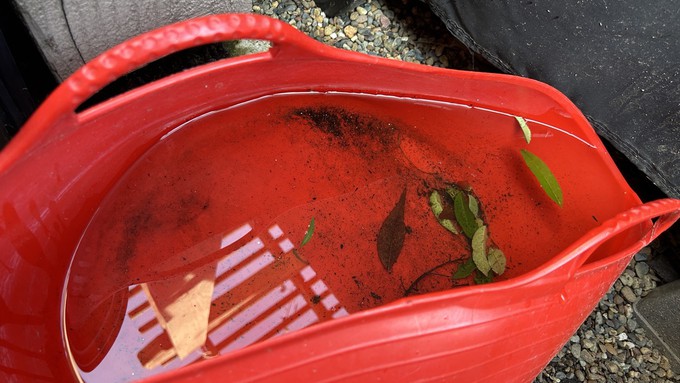
Trees got a good, deep soaking from recent 'atmospheric rivers'

The recent storms left behind a lot of water, but not too much for our soil to hold. (To guard against mosquitoes, be sure to empty any buckets and saucers of water before it warms up again.) Kathy Morrison
When it came to our latest atmospheric rivers, Sacramento found a sweet spot: Good steady rain with a chance to sink in.
In the first eight days of February, Downtown Sacramento received 2.15 inches of rain – double the average for that period, says the National Weather Service. That includes just over an inch during the storm that hit Sunday-Monday, Feb. 4-5, and another half inch on Wednesday, Feb. 7.
As a whole, Sacramento County collection sites averaged 3.32 inches for the first seven days of February, says the weather service. Our second rainiest month behind January, February normally totals 3.59 inches.
Most of that rain had a chance to soak in, replenishing reserves for our suburban forest and landscapes as well as local orchards. That’s good news for trees as they continue to recover from years of drought.
Some communities – particularly those closer to the Bay Area – have been even wetter this month. Davis, for example, recorded 4.13 inches in those first eight days – almost 3 inches above normal.
Locally, wind caused more issues than rain. The strong gusts that accompanied Sunday’s precipitation knocked over dozens of trees (and brought down lots of limbs) as well as many fences. But the local destruction was light compared to last winter’s storms that uprooted hundreds of drought-weakened trees in Sacramento and surrounding cities.
Elsewhere around California, this week’s storms took a heavy toll, causing flooding and mudslides. Long Beach (my hometown) totaled more than 10 inches Feb. 1-7; normal for that week is 0.79. That includes a record 3.16 inches on Tuesday, Feb. 6. Long Beach rarely gets more than 10 inches of rain in an entire year.
All this rain has prompted a wet outlook for our state’s water year. No drought is in the picture, says the National Integrated Drought Information System. (Find its localized data at https://www.drought.gov/.)
NIDIS expects our precipitation to continue to track high. The forecast calls for “60 to 70% probability of above normal precipitation” for the rest of February and “100 to 150% of normal precipitation” for the next 60 days.
Meanwhile, enjoy a sunny break in the weather. Sacramento’s next chance of showers is Thursday, Feb. 15.
More on local weather: https://www.weather.gov/sto/#
Comments
0 comments have been posted.Sacramento Digs Gardening to your inbox.
Food in My Back Yard Series
April 29: What's (already) wrong with my tomato plants?
April 22: Should you stock up on fertilizer? (Yes!)
April 15: Grow culinary herbs in containers
April 8: When to plant summer vegetables
April 1: Don't be fooled by these garden myths
March 25: Fertilizer tips: How to 'feed' your vegetables for healthy growth
March 18: Time to give vegetable seedlings some more space
March 11: Ways to win the fight against weeds
March 4: Potatoes from the garden
Feb. 25: Plant a fruit tree now -- for later
Feb. 18: How to squeeze more food into less space
Feb. 11: When to plant? Consider staggering your transplants
Feb. 4: Starting in seed starting
Sites We Like
Garden Checklist for week of May 4
Enjoy this spring weather – and get gardening!
* Plant, plant, plant! It’s prime planting season in the Sacramento area. Time to set out those tomato transplants along with peppers and eggplants. Pinch off any flowers on new transplants to make them concentrate on establishing roots instead of setting premature fruit.
* Direct-seed melons, cucumbers, summer squash, corn, radishes, pumpkins and annual herbs such as basil.
* Harvest cabbage, lettuce, peas and green onions.
* In the flower garden, direct-seed sunflowers, cosmos, salvia, zinnias, marigolds, celosia and asters. (You also can transplant seedlings for many of the same flowers.)
* Plant dahlia tubers. Other perennials to set out include verbena, coreopsis, coneflower and astilbe.
* Transplant petunias, marigolds and perennial flowers such as astilbe, columbine, coneflowers, coreopsis, dahlias, rudbeckia and verbena.
* Keep an eye out for slugs, snails, earwigs and aphids that want to dine on tender new growth.
* Feed summer bloomers with a balanced fertilizer.
* For continued bloom, cut off spent flowers on roses as well as other flowering plants.
* Add mulch to the garden to maintain moisture. Mulch also cuts down on weeds. But don’t let it mound around the stems or trunks of trees or shrubs. Leave about a 6-inch to 1-foot circle to avoid crown rot or other problems.